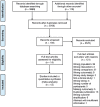Lipid-Lowering Efficacy of Ezetimibe in Patients with Atherosclerotic Cardiovascular Disease: A Systematic Review and Meta-Analyses
- PMID: 31724105
- PMCID: PMC7266788
- DOI: 10.1007/s40256-019-00379-9
Lipid-Lowering Efficacy of Ezetimibe in Patients with Atherosclerotic Cardiovascular Disease: A Systematic Review and Meta-Analyses
Abstract
Introduction: Patients with atherosclerotic cardiovascular disease (ASCVD), especially those with recent (< 1 year) acute coronary syndrome (ACS), are at high risk for recurrent cardiovascular events. This risk can be reduced by lowering low-density lipoprotein cholesterol (LDL-C) levels. A comprehensive meta-analysis on the LDL-C-lowering efficacy of ezetimibe is lacking. This study attempts to address this gap.
Methods: A systematic literature review of randomized controlled trials evaluating the LDL-C-lowering efficacy of ezetimibe in the ASCVD population was conducted. MEDLINE, EMBASE, and the Cochrane Central Register of Controlled Trials were searched for publications from database inception to August 2018 and for conference abstracts from 2015 to August 2018. Meta-analyses were conducted to evaluate the LDL-C-lowering efficacy of ezetimibe in the ASCVD population and the recent ACS subgroup.
Results: In total, 12 studies were eligible for the meta-analyses. Treatment with combination ezetimibe plus statin therapy showed greater absolute LDL-C reduction than statin monotherapy (mean difference - 21.86 mg/dL; 95% confidence interval [CI] - 26.56 to - 17.17; p < 0.0001) after 6 months of treatment (or at a timepoint closest to 6 months). Similarly, in patients with recent ACS, combination ezetimibe plus statin therapy was favorable compared with statin monotherapy (mean treatment difference - 19.19 mg/dL; 95% CI - 25.22 to - 13.16; p < 0.0001).
Conclusions: Ezetimibe, when added to statin therapy, provided a modest additional reduction in LDL-C compared with statin monotherapy. However, this may not be sufficient for some patients with ASCVD who have especially high LDL-C levels despite optimal statin therapy.
Conflict of interest statement
Fadia T. Shaya is Professor at the University of Maryland School of Pharmacy and has received consulting fees from Sanofi/Regeneron for general advice on study design. Krystal Sing is an employee of and stockholder in Regeneron Pharmaceuticals, Inc. Robert Milam, Fasahath Husain, and Michael A. del Aguila are employees of Doctor Evidence, which was contracted by Sanofi/Regeneron to participate in the design, conduct, and reporting of this study. Miraj Y. Patel is an employee of and stockholder in Sanofi.
Figures



Similar articles
-
The Effects of Statin Dose, Lipophilicity, and Combination of Statins plus Ezetimibe on Circulating Oxidized Low-Density Lipoprotein Levels: A Systematic Review and Meta-Analysis of Randomized Controlled Trials.Mediators Inflamm. 2021 Sep 4;2021:9661752. doi: 10.1155/2021/9661752. eCollection 2021. Mediators Inflamm. 2021. PMID: 34526854 Free PMC article.
-
Lipid-lowering treatment up to one year after acute coronary syndrome: guidance from a French expert panel for the implementation of guidelines in practice.Panminerva Med. 2023 Jun;65(2):244-249. doi: 10.23736/S0031-0808.22.04777-2. Epub 2022 Oct 12. Panminerva Med. 2023. PMID: 36222543 Review.
-
Alternative LDL Cholesterol-Lowering Strategy vs High-Intensity Statins in Atherosclerotic Cardiovascular Disease: A Systematic Review and Individual Patient Data Meta-Analysis.JAMA Cardiol. 2025 Feb 1;10(2):137-144. doi: 10.1001/jamacardio.2024.3911. JAMA Cardiol. 2025. PMID: 39565634
-
Low-density lipoprotein cholesterol targeting with pitavastatin + ezetimibe for patients with acute coronary syndrome and dyslipidaemia: the HIJ-PROPER study, a prospective, open-label, randomized trial.Eur Heart J. 2017 Aug 1;38(29):2264-2276. doi: 10.1093/eurheartj/ehx162. Eur Heart J. 2017. PMID: 28430910 Free PMC article. Clinical Trial.
-
The clinical effectiveness and safety of low/moderate-intensity statins & ezetimibe combination therapy vs. high-intensity statin monotherapy: a systematic review and meta-analysis.BMC Cardiovasc Disord. 2024 Nov 20;24(1):660. doi: 10.1186/s12872-024-04144-y. BMC Cardiovasc Disord. 2024. PMID: 39567875 Free PMC article.
Cited by
-
Clinical perspectives on ischemic stroke.Exp Neurol. 2021 Apr;338:113599. doi: 10.1016/j.expneurol.2021.113599. Epub 2021 Jan 10. Exp Neurol. 2021. PMID: 33440204 Free PMC article. Review.
-
Rosuvastatin-based combination treatment with acetylsalicylic acid or ezetimibe in the management of patients at high and very high cardiovascular risk. Expert opinion paper of the Polish Lipid Association 2025.Arch Med Sci. 2025 Jan 7;21(1):1-15. doi: 10.5114/aoms/199826. eCollection 2025. Arch Med Sci. 2025. PMID: 40190297 Free PMC article.
-
Ezetimibe and atherosclerotic cardiovascular disease: a systematic review and meta-analysis.Front Cardiovasc Med. 2023 Nov 24;10:1269172. doi: 10.3389/fcvm.2023.1269172. eCollection 2023. Front Cardiovasc Med. 2023. PMID: 38075958 Free PMC article. Review.
-
Achievement Rates for Low-Density Lipoprotein Cholesterol Goals in Patients at High Risk of Atherosclerotic Cardiovascular Disease in a Real-World Setting in Japan.J Atheroscler Thromb. 2023 Nov 1;30(11):1622-1634. doi: 10.5551/jat.63940. Epub 2023 Mar 16. J Atheroscler Thromb. 2023. PMID: 36928267 Free PMC article.
-
Estimated number and percentage of US adults with atherosclerotic cardiovascular disease recommended add-on lipid-lowering therapy by the 2018 AHA/ACC multi-society cholesterol guideline.Am Heart J Plus. 2022 Sep;21:100201. doi: 10.1016/j.ahjo.2022.100201. Epub 2022 Aug 27. Am Heart J Plus. 2022. PMID: 37168932 Free PMC article.
References
-
- Piepoli MF, Hoes AW, Agewall S, Albus C, Brotons C, Catapano AL, et al. 2016 European Guidelines on cardiovascular disease prevention in clinical practice: the Sixth Joint Task Force of the European Society of Cardiology and Other Societies on Cardiovascular Disease Prevention in Clinical Practice (constituted by representatives of 10 societies and by invited experts) developed with the special contribution of the European Association for Cardiovascular Prevention & Rehabilitation (EACPR) Eur Heart J. 2016;37(29):2315–2381. doi: 10.1093/eurheartj/ehw106. - DOI - PMC - PubMed
Publication types
MeSH terms
Substances
LinkOut - more resources
Full Text Sources
Medical
Miscellaneous

